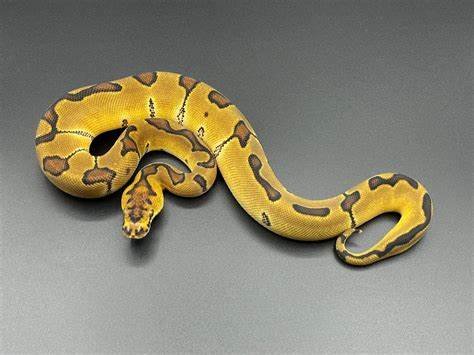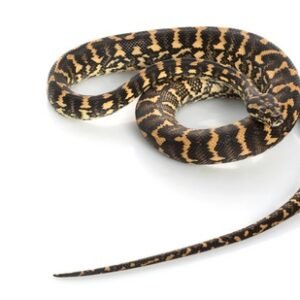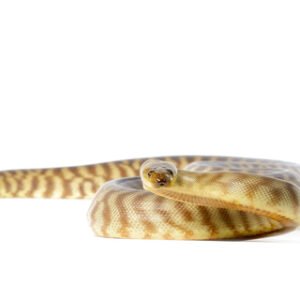The Fascinating World of Clown Ball Pythons: A Comprehensive Guide
Introduction to Clown Ball Pythons
Clown ball pythons are a distinctive morph of the widely popular ball python (Python regius), known for their striking appearance and fascinating genetic traits. These snakes are characterized by an unusual pattern that is generally lighter than the typical ball python, featuring a unique combination of colors, including rich golds, deep blacks, and sometimes even hues of orange. The defining trait of the clown morph is the absence of certain darker pigments, giving it an almost ‘clown-like’ appearance, with a remarkable pattern that appears more defined and striking than that of many other morphs.
The origin of clown ball pythons can be traced back to the early 2000s when breeders began to explore different genetic mutations within the ball python species. The clown mutation is a recessive trait, meaning that both parent snakes must carry the gene to produce offspring with this unique appearance. This aspect of clown ball pythons not only adds to the allure but also presents interesting opportunities for responsible breeders looking to create new morph combinations. The fascination with these snakes has led to increased interest from reptile enthusiasts who appreciate not just their visual appeal but also the genetic complexities involved in breeding.
Within the ball python community, clown ball pythons hold a special place due to their unique patterns and colors, making them a preferred choice for many reptile collectors. Their captivating appearance, combined with their relatively calm demeanor, enhances their desirability as pets. Additionally, the clown ball python’s genetic makeup allows for diverse breeding possibilities, resulting in numerous morph combinations that continue to excite both seasoned and novice keepers alike. Understanding these aspects provides a foundational knowledge for anyone interested in the stunning world of clown ball pythons.
Physical Appearance and Morph Characteristics
The clown ball python is renowned for its striking physical appearance and unique morph characteristics, setting it apart from other varieties of this popular snake species. One of the most notable traits of the clown ball python is its distinct pattern. The morph displays an intricate combination of light and dark coloration, often featuring bright gold, yellow, and deep brown shades that contribute to its captivating look. The specific patterns may include circular or oval-shaped blotches, which create a visually appealing contrast against the base coloration. This distinctive appearance has made them particularly sought after among breeders and collectors.
The coloration of clown ball pythons can vary significantly as they mature, shifting from vibrant juveniles to more subdued adult tones. These changes can include deeper and more pronounced patterns, allowing for a greater range of individual appearance. Breeders often seek out specific color variations, resulting in a diverse array of clown ball python morphs. Moreover, no two individuals are precisely alike, making each one unique, which adds to their allure in the exotic pet market.
In terms of size, clown ball pythons typically reach an average length of 3 to 5 feet, with a robust body structure that is characteristic of the species. These snakes have a well-defined head and a short, thick neck that adds to their striking stature. Understanding the physical traits of clown ball pythons is essential, especially for enthusiasts keen on identifying and appreciating the specific characteristics that set these creatures apart in the vast world of snake morphs. Their unique appearance not only attracts collectors but also serves as a focal point for breeding projects aimed at enhancing particular traits within the morph.
Care and Maintenance of Clown Ball Pythons
Clown Ball Pythons, known for their unique coloration and patterns, require specific care to thrive in captivity. Establishing a proper habitat is crucial. These snakes thrive in an enclosure that mimics their natural environment. A spacious terrarium of at least 40 gallons is recommended for an adult snake, providing ample room for movement. The substrate should be both comfortable and easy to clean, with options including aspen shavings or coconut fiber. Hiding spots are essential; include at least two to three forms of shelter, such as caves or logs, to help the snake feel secure.
Temperature regulation is another vital aspect of their care. A gradient heating system should be created, with a basking area maintained at 88-92°F (31-33°C) and a cooler area at 75-80°F (24-27°C). This temperature variation allows the snake to thermoregulate effectively. Humidity levels should be kept between 50-60%. Utilizing a hygrometer can assist in monitoring humidity. Mist the enclosure lightly every few days to maintain optimal moisture levels.
Feeding Clown Ball Pythons is relatively straightforward, as they typically consume rodents. Hatchlings can be fed appropriately sized prey, such as pinky mice, while adults may require larger meals like medium-sized rats. It is advisable to feed them every 7-14 days, depending on their age and size. Always ensure that the prey is thawed completely if previously frozen and monitor the snake’s feeding habits to adjust the schedule as needed.
Handling is another critical aspect of care. Clown Ball Pythons tend to be docile; however, regular, gentle handling helps them become accustomed to human interaction. Aim for short sessions a few times a week, and be sure to always support their body adequately. By fostering a routine, owners can build trust and a positive bond with their pet, crucial for both the animal’s well-being and the owner’s enjoyment of their companionship.
Breeding Clown Ball Pythons: Tips and Considerations
Breeding Clown Ball Pythons is a fascinating endeavor that combines genetics with husbandry skills. To get started, it is essential to understand the genetic principles that govern the clown morph. Clown Ball Pythons are the result of a recessive genetic trait, meaning both parent snakes must carry the clown gene for the offspring to inherit this striking appearance. When planning a breeding project, one should consider pairing strategies that not only focus on producing clown morphs but also incorporate other desirable traits from various morphs to enhance the overall quality of the litter.
When selecting breeding pairs, it is wise to thoroughly research the lineage of the snakes to avoid genetic complications and improve the chances of healthy offspring. Breeders may opt to pair a clown male with a female carrying a co-dominant or recessive gene, such as pastel or enchi, to produce visually appealing combinations. Moreover, keeping records of breeding outcomes helps in tracking the success of these pairings and refining future strategies. It is advisable to maintain optimal health for both breeding adults and the hatchlings by providing appropriate nutrition, housing, and veterinary care throughout the breeding process.
However, breeding snakes comes with responsibilities and ethical considerations. Breeders must ensure they are not contributing to issues like overpopulation or the neglect of reptiles. It is crucial to have a plan for all offspring, whether that includes keeping them, selling ethically, or placing them into suitable homes. By adhering to healthy breeding practices and championing the well-being of the snakes, breeders contribute positively to the reptile community. Thus, a committed approach to breeding Clown Ball Pythons is not only rewarding in terms of the emerging morphs but also fosters a responsible and sustainable reptile culture.





